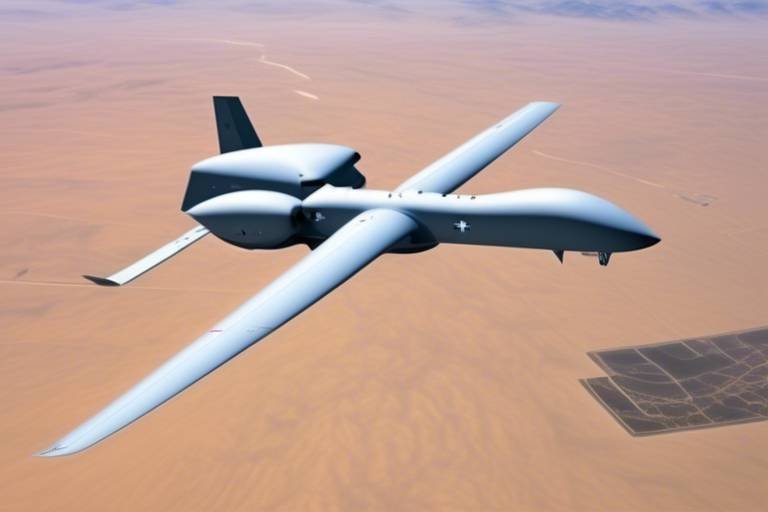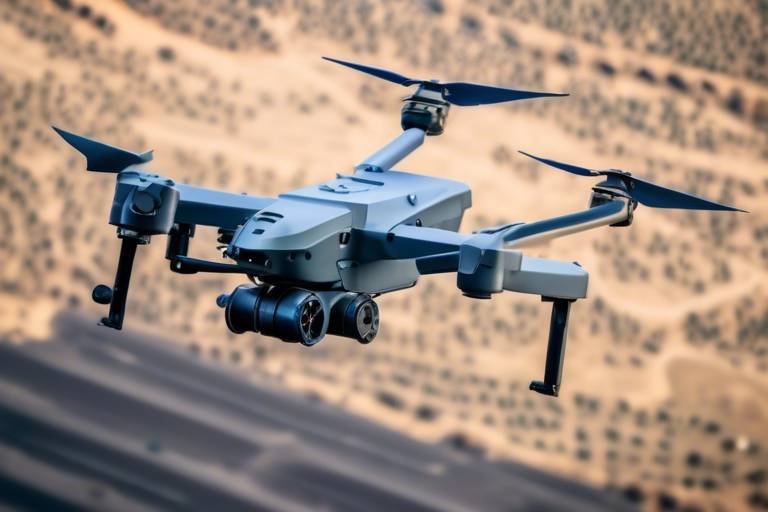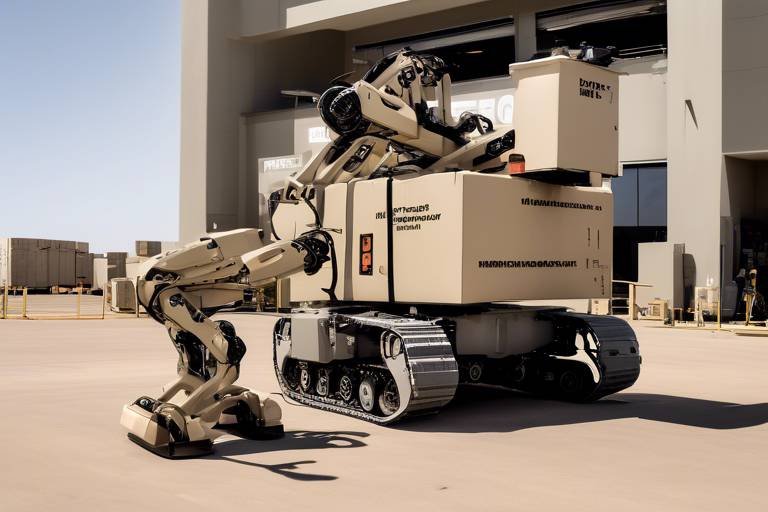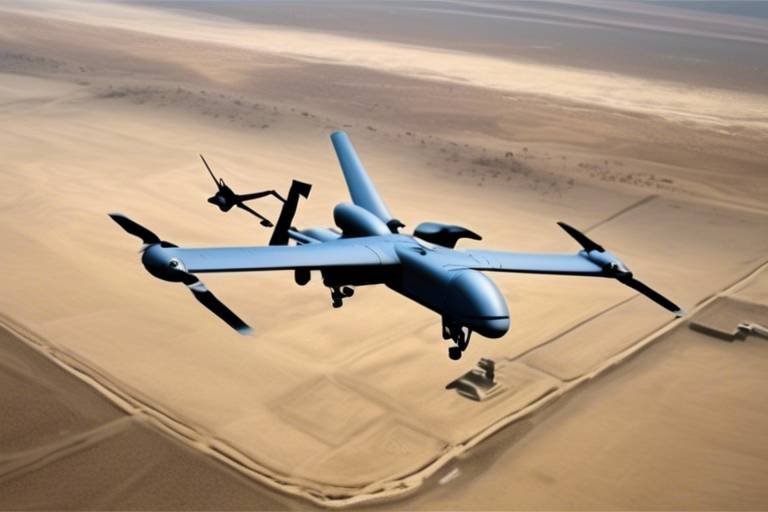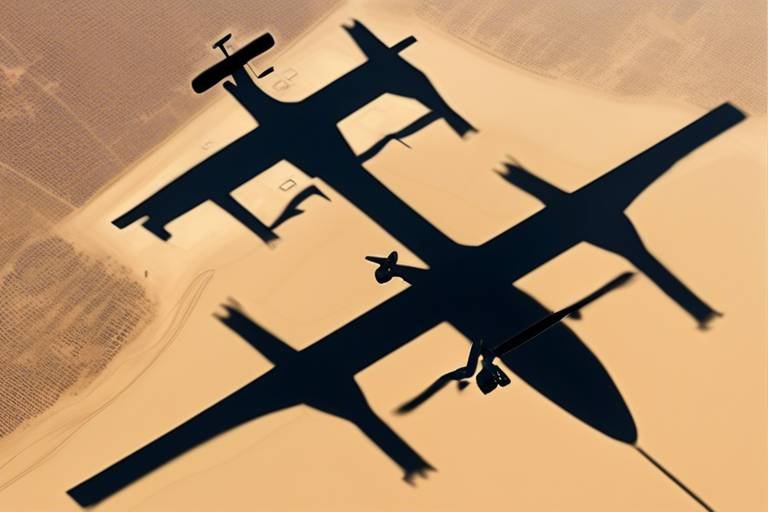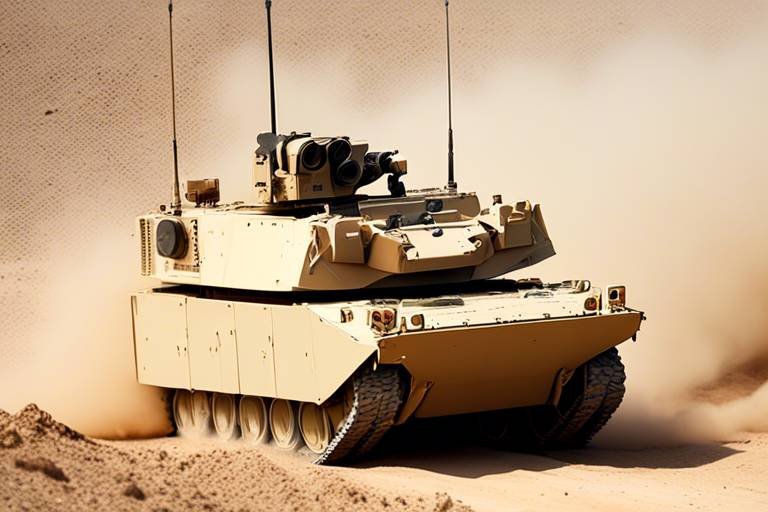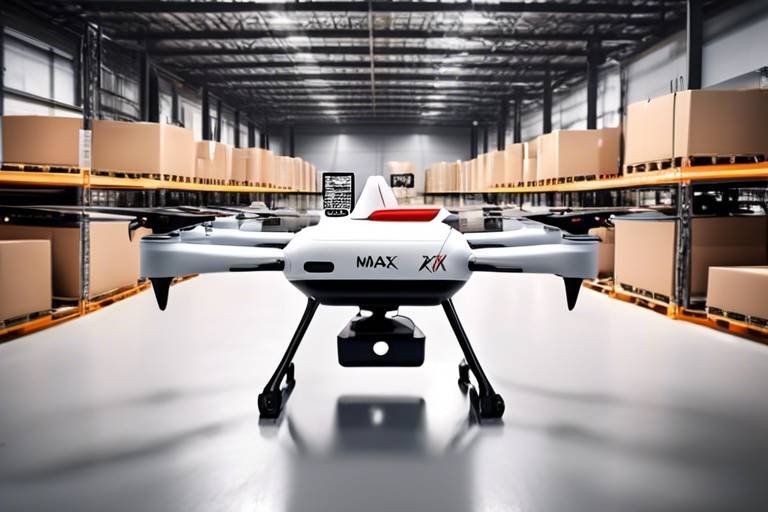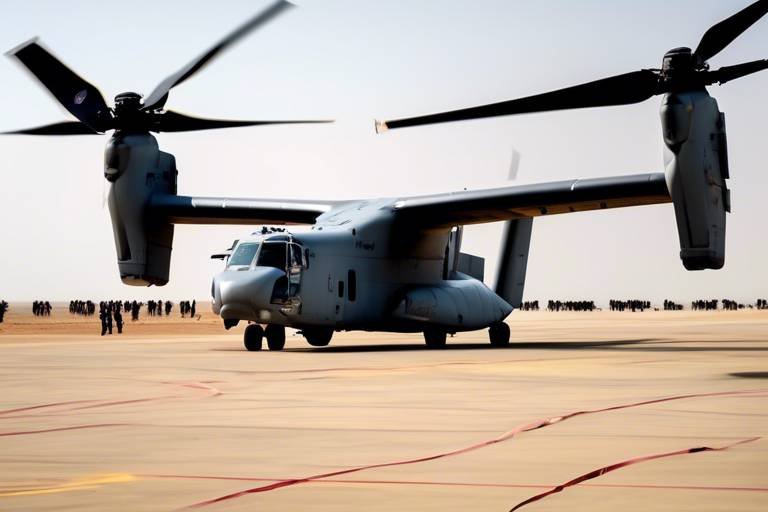The Use of the RQ-4A Global Hawk in Strategic Surveillance
The RQ-4A Global Hawk is not just another drone; it represents a leap in aerial surveillance technology that has transformed modern military operations. Imagine having an eye in the sky that can watch over vast territories without ever needing to touch the ground. This is precisely what the Global Hawk does, and its significance in strategic surveillance cannot be overstated. With its ability to fly at high altitudes for extended periods, it gathers crucial intelligence that shapes military strategies and enhances operational effectiveness.
In today’s complex battlefield, information is power. The Global Hawk acts as a sentinel, providing real-time data that can mean the difference between success and failure in military operations. Its role goes beyond mere observation; it’s about understanding the battlefield landscape, monitoring enemy movements, and providing actionable insights to ground troops and command centers alike. As we delve deeper into the capabilities of the RQ-4A, it becomes clear that this unmanned aerial vehicle (UAV) is a game-changer in the realm of strategic surveillance.
With its advanced technological features, the Global Hawk is equipped to handle a variety of missions, from reconnaissance to target acquisition. It operates in a realm where traditional aircraft might falter, especially in hostile environments where threats are omnipresent. The UAV's ability to gather high-resolution imagery and data from extensive areas allows military leaders to make informed decisions swiftly and effectively. As we explore its features and operational roles, you'll see how the RQ-4A Global Hawk stands at the forefront of modern military surveillance.
- What is the primary purpose of the RQ-4A Global Hawk?
The primary purpose of the RQ-4A Global Hawk is to conduct high-altitude, long-endurance surveillance missions, providing critical intelligence for military operations. - How does the Global Hawk maintain communication with ground forces?
The Global Hawk employs sophisticated communication systems that ensure real-time data transmission, allowing for timely intelligence sharing. - What are the main challenges faced by the RQ-4A Global Hawk?
Challenges include vulnerability to electronic warfare, operational restrictions due to environmental factors, and potential limitations in certain geographical areas.

Overview of the RQ-4A Global Hawk
This article explores the capabilities and significance of the RQ-4A Global Hawk in modern military operations, emphasizing its role in strategic surveillance and intelligence gathering.
The RQ-4A Global Hawk is not just any unmanned aerial vehicle (UAV); it is a game-changer in the realm of high-altitude, long-endurance missions. Designed by Northrop Grumman, this remarkable aircraft provides crucial data that supports military and intelligence operations around the globe. Imagine having the ability to monitor vast stretches of land from the comfort of a control room thousands of miles away—this is precisely what the Global Hawk offers. Its ability to fly at altitudes exceeding 60,000 feet means it can operate above most weather systems and traditional air defenses, making it a strategic asset in both peacetime and combat scenarios.
Equipped with a wingspan similar to that of a Boeing 737, the Global Hawk is engineered for endurance. It can remain airborne for over 30 hours, continuously collecting data. This capability allows military planners to gather real-time intelligence without the risk of losing personnel or aircraft. The data collected can include everything from high-resolution imagery to signals intelligence, which is invaluable for understanding enemy movements and intentions.
Moreover, the Global Hawk's operational flexibility means it can be deployed for various missions, including:
- Reconnaissance: Gathering intelligence on enemy locations and activities.
- Surveillance: Monitoring specific areas for extended periods.
- Target Acquisition: Identifying and tracking potential targets for military action.
In summary, the RQ-4A Global Hawk represents a significant leap in military technology. Its combination of high-altitude flight, long endurance, and advanced sensor capabilities make it an essential tool for modern military operations, ensuring that decision-makers have the most accurate and timely information at their fingertips.
The Global Hawk features cutting-edge technology, including advanced sensors and communication systems, enabling it to capture high-resolution imagery and gather vital intelligence from vast areas.
Equipped with various sensors, the Global Hawk can detect and analyze different types of data, from infrared imagery to synthetic aperture radar, enhancing its surveillance effectiveness.
These sensors allow the Global Hawk to provide real-time imaging, making it invaluable for monitoring enemy movements and assessing battlefield conditions.
SAR technology enables the Global Hawk to penetrate cloud cover and operate in all weather conditions, ensuring continuous surveillance capabilities.
The RQ-4A employs sophisticated communication systems that facilitate data transmission, ensuring timely intelligence sharing with ground forces and command centers.
The Global Hawk serves multiple roles, including reconnaissance, surveillance, and target acquisition, making it a versatile asset in both peacetime and combat operations.
Its ability to cover large areas efficiently makes the Global Hawk ideal for reconnaissance missions, providing strategic insights into enemy positions and movements.
The Global Hawk plays a critical role in supporting ground operations by delivering real-time intelligence, enhancing situational awareness for military personnel in the field.
The deployment of the RQ-4A Global Hawk has significantly altered military strategy, influencing decision-making processes and operational planning in various conflict zones.
Despite its advanced capabilities, the Global Hawk faces challenges such as vulnerability to enemy defenses and limitations in operating environments, which must be addressed for optimal effectiveness.
The RQ-4A can be susceptible to electronic warfare tactics, which may disrupt its operations and compromise data integrity during missions.
Certain environmental factors, such as extreme weather and geographical limitations, can hinder the Global Hawk's performance, necessitating careful mission planning.
As military technology evolves, the RQ-4A Global Hawk is expected to undergo enhancements, ensuring it remains a vital tool for strategic surveillance in future conflicts.
- What is the maximum altitude the RQ-4A can reach? The RQ-4A can fly at altitudes exceeding 60,000 feet.
- How long can the Global Hawk stay in the air? It can remain airborne for over 30 hours.
- What types of missions can the Global Hawk perform? It can conduct reconnaissance, surveillance, and target acquisition missions.
- Is the Global Hawk vulnerable to enemy defenses? Yes, it can be susceptible to electronic warfare tactics, which may disrupt its operations.

Technological Advancements
This article explores the capabilities and significance of the RQ-4A Global Hawk in modern military operations, emphasizing its role in strategic surveillance and intelligence gathering.
The RQ-4A Global Hawk is an unmanned aerial vehicle designed for high-altitude, long-endurance missions, providing crucial data for military and intelligence operations worldwide.
The Global Hawk is not just another drone; it’s a technological marvel that has transformed the way military operations are conducted. With its cutting-edge technology, the Global Hawk stands tall in the realm of unmanned aerial vehicles (UAVs). It boasts advanced sensors and communication systems that allow it to capture high-resolution imagery and gather vital intelligence over vast areas, making it an indispensable asset for military strategists.
One of the standout features of the Global Hawk is its sensor capabilities. These sensors are like the eyes of the drone, allowing it to detect and analyze a multitude of data types. From infrared imagery to synthetic aperture radar (SAR), the Global Hawk enhances its surveillance effectiveness significantly. Imagine being able to see through clouds or at night—this is what these sensors enable. They provide a comprehensive view of the battlefield, ensuring that military leaders have the information they need at their fingertips.
Equipped with a range of sensors, the Global Hawk is capable of performing various surveillance tasks. Here’s a closer look at some of its key sensor technologies:
- Electro-Optical/Infrared Sensors: These sensors allow the Global Hawk to provide real-time imaging. This capability is invaluable for monitoring enemy movements and assessing battlefield conditions, giving military commanders a clear picture of what’s happening on the ground.
- Synthetic Aperture Radar (SAR): SAR technology enables the Global Hawk to penetrate cloud cover and operate in all weather conditions, ensuring continuous surveillance capabilities. Whether it's rain, fog, or even snow, the Global Hawk can maintain its watchful gaze.
The electro-optical/infrared sensors are akin to having a high-definition camera that can also see in the dark. This feature allows the Global Hawk to monitor activities in real-time, making it an essential tool for reconnaissance missions. Imagine being able to track troop movements or identify potential threats without ever being detected—this is the power of these sensors.
SAR technology is like having X-ray vision for the drone. It can see through clouds, smoke, and even darkness, allowing for uninterrupted surveillance. This capability means that military operations can continue regardless of weather conditions, providing a strategic advantage that is hard to overstate.
The communication systems employed by the RQ-4A are just as impressive as its sensors. They facilitate seamless data transmission, ensuring that intelligence is shared in real-time with ground forces and command centers. Think of it as a high-speed internet connection for military operations. This instantaneous sharing of information can be the difference between success and failure in critical situations.
In summary, the technological advancements embodied in the RQ-4A Global Hawk are nothing short of revolutionary. From its sophisticated sensors that can see through the toughest conditions to its advanced communication systems that keep military personnel informed, this drone is a game-changer in strategic surveillance.
The Global Hawk serves multiple roles, including reconnaissance, surveillance, and target acquisition, making it a versatile asset in both peacetime and combat operations.
Its ability to cover large areas efficiently makes the Global Hawk ideal for reconnaissance missions, providing strategic insights into enemy positions and movements.
The Global Hawk plays a critical role in supporting ground operations by delivering real-time intelligence, enhancing situational awareness for military personnel in the field.
The deployment of the RQ-4A Global Hawk has significantly altered military strategy, influencing decision-making processes and operational planning in various conflict zones.
Despite its advanced capabilities, the Global Hawk faces challenges such as vulnerability to enemy defenses and limitations in operating environments, which must be addressed for optimal effectiveness.
The RQ-4A can be susceptible to electronic warfare tactics, which may disrupt its operations and compromise data integrity during missions.
Certain environmental factors, such as extreme weather and geographical limitations, can hinder the Global Hawk's performance, necessitating careful mission planning.
As military technology evolves, the RQ-4A Global Hawk is expected to undergo enhancements, ensuring it remains a vital tool for strategic surveillance in future conflicts.
- What is the primary purpose of the RQ-4A Global Hawk?
- The primary purpose of the RQ-4A Global Hawk is to conduct high-altitude, long-endurance surveillance and reconnaissance missions to gather intelligence.
- How does the Global Hawk transmit data?
- The Global Hawk employs sophisticated communication systems that facilitate real-time data transmission to ground forces and command centers.
- Can the Global Hawk operate in adverse weather conditions?
- Yes, the Global Hawk is equipped with Synthetic Aperture Radar (SAR) technology, allowing it to operate in all weather conditions, including rain and fog.
- What are the limitations of the RQ-4A Global Hawk?
- Some limitations include vulnerability to electronic warfare and operational restrictions due to extreme weather and geographical challenges.

Sensor Capabilities
The RQ-4A Global Hawk is not just another drone; it’s a technological marvel that stands at the forefront of military surveillance. One of its most impressive features is its . These sensors are the eyes and ears of the Global Hawk, allowing it to gather critical intelligence from the battlefield without putting any personnel at risk. Imagine having a bird's eye view of enemy movements, terrain changes, and even weather patterns—all from thousands of feet in the air. This capability transforms how military operations are planned and executed.
Equipped with a variety of sensors, the Global Hawk can detect and analyze numerous types of data, making it an invaluable asset for strategic surveillance. Here are some of the key sensor types:
- Electro-Optical/Infrared Sensors: These sensors provide real-time imaging, which is crucial for monitoring enemy activities and assessing battlefield conditions. They can capture high-resolution images during both day and night, allowing military commanders to make informed decisions based on the latest data.
- Synthetic Aperture Radar (SAR): This advanced technology enables the Global Hawk to penetrate cloud cover and operate effectively in all weather conditions. Whether it’s a sunny day or a stormy night, the SAR ensures that surveillance can continue uninterrupted, providing a constant stream of intelligence.
To illustrate the differences between these sensor types, consider the following table:
| Sensor Type | Capabilities | Operational Use |
|---|---|---|
| Electro-Optical/Infrared | Real-time imaging, day/night capability | Monitoring movements, assessing battlefield conditions |
| Synthetic Aperture Radar | All-weather operation, cloud penetration | Continuous surveillance, terrain mapping |
This combination of sensors allows the Global Hawk to gather a wealth of information that can be crucial for mission success. The ability to switch between different types of data collection means that military strategists can adapt their approach based on the situation at hand. For example, if visibility is poor due to weather conditions, the SAR can still provide valuable insights, ensuring that no opportunity for intelligence gathering is lost.
In summary, the sensor capabilities of the RQ-4A Global Hawk are what set it apart from traditional surveillance methods. By integrating advanced technologies like electro-optical/infrared and synthetic aperture radar, this unmanned aerial vehicle can perform a range of missions that are vital for modern warfare. It’s like having a highly skilled scout that can operate in any environment, providing the military with the upper hand in strategic planning and execution.
Q1: How does the Global Hawk gather intelligence?
A1: The Global Hawk uses advanced sensors, including electro-optical/infrared and synthetic aperture radar, to capture high-resolution images and gather various types of data from the battlefield.
Q2: Can the Global Hawk operate in adverse weather conditions?
A2: Yes, the Global Hawk is equipped with synthetic aperture radar, which allows it to operate effectively in all weather conditions, including cloudy or stormy environments.
Q3: What is the significance of real-time imaging?
A3: Real-time imaging allows military commanders to monitor enemy movements and assess battlefield conditions as they happen, enabling quick decision-making and strategic planning.

Electro-Optical/Infrared Sensors
The RQ-4A Global Hawk is equipped with state-of-the-art Electro-Optical/Infrared (EO/IR) sensors, which are pivotal in enhancing its surveillance capabilities. These sensors allow the UAV to capture real-time imaging, making it an invaluable asset for military operations. Imagine having a pair of eyes that can see through the fog of war, providing crystal-clear visuals of enemy movements and battlefield conditions. That’s precisely what these sensors do—they transform the Global Hawk into a watchful guardian in the sky.
EO/IR sensors operate by detecting infrared radiation emitted from objects, thereby enabling the Global Hawk to identify and track targets even in low-light or obscured conditions. This capability is crucial for various missions, such as reconnaissance and surveillance, where understanding the battlefield environment can mean the difference between success and failure. For instance, during nighttime operations, traditional visual means may falter, but the EO/IR sensors continue to provide vital data, ensuring that military forces remain one step ahead of their adversaries.
Furthermore, the integration of EO/IR sensors into the Global Hawk’s systems allows for a range of operational benefits:
- Real-time Targeting: The ability to provide immediate feedback to ground troops enhances situational awareness and decision-making.
- High-resolution Imaging: The sensors can capture detailed images, allowing for precise assessment of enemy positions and movements.
- Multi-spectral Capability: The combination of optical and infrared imaging enables the detection of both visible and thermal signatures.
In summary, the Electro-Optical/Infrared sensors on the RQ-4A Global Hawk serve as a powerful tool in modern military operations. They not only enhance the UAV's surveillance capabilities but also provide critical intelligence that can shape the outcome of missions. As technology continues to advance, we can expect these sensors to evolve further, offering even greater precision and insight into complex operational environments.
- What are Electro-Optical/Infrared sensors?
EO/IR sensors are devices that detect infrared radiation and visible light, allowing for real-time imaging of targets, even in challenging conditions. - How does the Global Hawk use these sensors?
The Global Hawk employs EO/IR sensors to gather intelligence, monitor enemy movements, and support ground troops by providing detailed situational awareness. - Can EO/IR sensors operate at night?
Yes, these sensors are specifically designed to function in low-light conditions, making them highly effective for nighttime operations.

Synthetic Aperture Radar
The Synthetic Aperture Radar (SAR) technology integrated into the RQ-4A Global Hawk is a game-changer in the realm of aerial surveillance. Unlike traditional optical sensors that rely on clear skies and daylight, SAR operates by sending out radio waves that bounce off the ground and return to the sensor. This capability enables the Global Hawk to penetrate cloud cover and gather data even during adverse weather conditions, making it an invaluable asset for military operations.
Imagine trying to take a photograph through a foggy window; you might miss crucial details. However, with SAR, it's like having a special lens that cuts through the fog, revealing the picture behind it. This technology allows the Global Hawk to capture high-resolution images of the terrain below, regardless of the weather, and at any time of day or night. This capability is essential for maintaining situational awareness in dynamic combat environments.
One of the standout features of SAR is its ability to generate detailed images of the landscape and identify moving targets. It does this by using a technique called interferometry, which compares multiple radar images to detect changes over time. This means that military strategists can track the movement of enemy forces, assess troop concentrations, and even monitor changes in infrastructure, all from the safety of the skies.
Moreover, the data collected by SAR is not just limited to visual imagery. It can also be processed to create 3D terrain maps, which are invaluable for planning missions and understanding the battlefield. These maps can inform decisions on troop deployments, logistics, and even potential evacuation routes. The versatility of SAR technology enhances the Global Hawk's operational effectiveness, allowing it to serve multiple roles within military strategy.
In summary, the Synthetic Aperture Radar aboard the RQ-4A Global Hawk is a critical component that elevates its surveillance capabilities. By providing real-time, all-weather, high-resolution imagery, SAR ensures that military forces can maintain a tactical advantage, making informed decisions based on comprehensive intelligence. As military operations become increasingly complex, the importance of such advanced technologies cannot be overstated.
- What is Synthetic Aperture Radar?
SAR is a form of radar that uses motion to improve the resolution of images, allowing for detailed surveillance regardless of weather conditions. - How does SAR work?
SAR transmits radio waves towards the ground, which bounce back to the sensor. By analyzing these signals, it creates high-resolution images of the terrain. - What are the advantages of using SAR in military operations?
SAR provides all-weather, day-and-night imaging capabilities, which are crucial for reconnaissance and surveillance missions. - Can SAR be used for purposes other than military?
Yes, SAR technology is also used in environmental monitoring, disaster management, and urban planning.

Communication Systems
The RQ-4A Global Hawk is not just a marvel of engineering; it is also a sophisticated communication hub that plays a pivotal role in modern military operations. Imagine a bird soaring high above the battlefield, its eyes scanning the ground below while simultaneously sharing critical information with its handlers. This is precisely what the Global Hawk achieves through its advanced communication systems. These systems are designed to facilitate seamless data transmission, ensuring that real-time intelligence reaches ground forces and command centers without delay.
At the heart of the Global Hawk's communication capabilities is its ability to operate on multiple frequencies and utilize various transmission methods. This versatility allows it to adapt to different operational environments and maintain contact even in challenging conditions. The UAV employs satellite communication (SATCOM) links, which enable it to send and receive data over vast distances, making it an invaluable asset for long-range missions. This capability is particularly crucial during reconnaissance missions where timely information can mean the difference between success and failure.
Moreover, the Global Hawk's communication systems are equipped with advanced encryption technologies to safeguard the data being transmitted. In a world where information warfare is becoming increasingly prevalent, protecting sensitive intelligence from enemy interception is paramount. The use of secure communication channels ensures that the data collected by the Global Hawk remains confidential and reliable, allowing commanders to make informed decisions based on accurate intelligence.
To provide a clearer understanding of the communication systems, here’s a brief comparison of the main components utilized by the RQ-4A Global Hawk:
| Communication Component | Functionality |
|---|---|
| Satellite Communication (SATCOM) | Enables long-range data transmission and real-time communication with command centers. |
| Line-of-Sight (LOS) Communication | Facilitates direct communication with ground forces during closer operations. |
| Data Link Systems | Ensures secure and encrypted data transmission for intelligence sharing. |
In summary, the communication systems of the RQ-4A Global Hawk are a testament to the integration of cutting-edge technology in military operations. They not only enhance the UAV's operational effectiveness but also ensure that the data it gathers is utilized to its fullest potential. As military strategies evolve, the importance of robust communication systems will only grow, making the Global Hawk an indispensable tool on the modern battlefield.
- What type of data can the RQ-4A Global Hawk transmit?
The Global Hawk can transmit various types of data, including high-resolution imagery, video feeds, and sensor data, ensuring comprehensive situational awareness. - How does the Global Hawk ensure data security?
It employs advanced encryption technologies and secure communication channels to protect sensitive information from interception by adversaries. - Can the Global Hawk operate in adverse weather conditions?
Yes, thanks to its advanced communication systems and sensor capabilities, the Global Hawk can continue to operate effectively in various weather conditions.

Operational Roles
The RQ-4A Global Hawk is not just another drone; it’s a game-changer in military operations. Its operational versatility allows it to fulfill multiple roles, making it an indispensable asset in both peacetime and combat scenarios. Imagine having an eye in the sky that can not only watch over vast territories but also provide actionable intelligence that can sway the outcome of military engagements. This is precisely what the Global Hawk delivers.
One of the primary roles of the Global Hawk is reconnaissance. With its ability to cover large areas efficiently, it serves as a critical tool for gathering intelligence on enemy positions and movements. Picture a chess game where each move is crucial; the Global Hawk provides the necessary insights to anticipate the opponent's next steps. By flying at high altitudes, it can gather data without being easily detected, allowing military planners to strategize effectively.
Additionally, the Global Hawk plays a vital role in supporting ground troops. Imagine soldiers on the battlefield with limited visibility; the Global Hawk swoops in with real-time intelligence, enhancing their situational awareness. This capability is particularly valuable in dynamic combat environments where conditions can change rapidly. By relaying information about troop movements, potential threats, and environmental conditions, the Global Hawk ensures that ground forces are always one step ahead.
Furthermore, the operational roles of the Global Hawk extend beyond mere surveillance. It can also assist in target acquisition, which is crucial in precision strikes. By identifying and classifying targets, the Global Hawk helps to minimize collateral damage and increase mission success rates. This multifaceted approach to military operations underscores how the Global Hawk is not just a tool but a strategic partner in modern warfare.
In summary, the operational roles of the RQ-4A Global Hawk encompass reconnaissance, support for ground troops, and target acquisition. Its advanced technology and capabilities enable it to adapt to various military needs, making it a versatile asset that continues to shape the landscape of modern military operations.
- What is the primary function of the RQ-4A Global Hawk?
The primary function is strategic surveillance and intelligence gathering, allowing military operations to be informed and effective. - How does the Global Hawk support ground troops?
It provides real-time intelligence, enhancing situational awareness and informing tactical decisions on the battlefield. - Can the Global Hawk operate in all weather conditions?
Yes, it utilizes Synthetic Aperture Radar technology, which allows it to penetrate cloud cover and operate effectively in adverse weather. - What are some limitations of the Global Hawk?
It can be vulnerable to electronic warfare tactics and may face operational restrictions due to extreme weather or geographical factors.

Reconnaissance Missions
The RQ-4A Global Hawk has revolutionized the way military forces conduct . Imagine having an eye in the sky that can survey vast landscapes without putting personnel at risk. This unmanned aerial vehicle (UAV) excels in covering large areas efficiently, providing commanders with critical insights into enemy positions and movements. The ability to gather real-time data is akin to having a tactical advantage that can turn the tide of operations.
One of the most impressive aspects of the Global Hawk is its long-endurance capability. With the ability to stay aloft for over 30 hours, it can continuously monitor a designated area, capturing detailed imagery and data that are vital for strategic planning. This endurance allows military planners to maintain a persistent presence over conflict zones, ensuring that they are always one step ahead of potential threats.
In reconnaissance missions, the Global Hawk utilizes a variety of advanced sensors to collect diverse types of intelligence. These sensors can detect everything from troop movements to infrastructure changes, making it an invaluable asset for military operations. For instance, the integration of electro-optical/infrared sensors allows the Global Hawk to provide real-time imaging, which is crucial for assessing battlefield conditions and monitoring enemy activities.
Moreover, the UAV's high-resolution imagery capabilities enable it to perform detailed analysis of terrain and enemy positions. This is particularly important in complex environments where traditional reconnaissance methods may fall short. The data collected can be processed and analyzed quickly, providing commanders with actionable intelligence that can inform their next moves.
To illustrate the effectiveness of the Global Hawk in reconnaissance missions, consider the following table that summarizes its key features:
| Feature | Description |
|---|---|
| Flight Endurance | Over 30 hours of continuous flight |
| Operational Altitude | Up to 60,000 feet |
| Sensor Types | Electro-Optical, Infrared, Synthetic Aperture Radar |
| Data Transmission | Real-time data sharing with ground forces |
In conclusion, the RQ-4A Global Hawk is not just a technological marvel; it is a game-changer in reconnaissance missions. Its ability to provide comprehensive surveillance while minimizing risks to personnel underscores its significance in modern military operations. As military strategies evolve, the importance of such UAVs will only increase, shaping the future of reconnaissance and surveillance in conflict zones.
- What is the primary function of the RQ-4A Global Hawk?
The primary function of the RQ-4A Global Hawk is to conduct high-altitude, long-endurance reconnaissance missions, providing real-time intelligence and surveillance data. - How long can the Global Hawk stay in the air?
The Global Hawk can remain airborne for over 30 hours, allowing for extensive monitoring of areas of interest. - What types of sensors does the Global Hawk use?
The Global Hawk is equipped with various sensors, including electro-optical, infrared, and synthetic aperture radar, enabling it to gather diverse types of intelligence. - How does the Global Hawk share data with ground forces?
The Global Hawk employs sophisticated communication systems that facilitate real-time data transmission to ground forces and command centers.

Support for Ground Troops
The RQ-4A Global Hawk is not just a marvel of engineering; it serves as a lifeline for ground troops operating in hostile environments. Imagine being a soldier on the front lines, where every second counts, and the fog of war can be thick enough to cut through. The Global Hawk swoops in like a guardian angel, providing real-time intelligence that can mean the difference between life and death. Its ability to gather and relay critical information allows commanders to make informed decisions quickly, significantly enhancing the safety and effectiveness of ground operations.
One of the standout features of the Global Hawk is its capability to conduct surveillance over vast areas without putting personnel at risk. This unmanned aerial vehicle can linger in the skies for hours, capturing high-resolution images and relaying them back to command centers. For instance, if ground troops are advancing towards a suspected enemy position, the Global Hawk can monitor the area, providing updates on troop movements, enemy locations, and even potential ambushes. This level of situational awareness is invaluable, allowing ground forces to adapt their strategies in real time.
Moreover, the Global Hawk's advanced communication systems ensure that the information it gathers is transmitted swiftly and securely. This capability is crucial during operations where timing is everything. When troops are engaged in combat, having access to accurate and up-to-date intelligence can help them maneuver more effectively and avoid unnecessary casualties. In many cases, the Global Hawk acts as an eye in the sky, watching over ground troops as they navigate treacherous terrains.
In addition to its surveillance capabilities, the Global Hawk can also support ground troops in other ways. For example, it can assist in target acquisition, helping to identify and prioritize threats based on the real-time data it collects. This capability not only improves operational efficiency but also enhances the safety of soldiers on the ground. The Global Hawk can provide a comprehensive view of the battlefield, allowing ground forces to focus on their missions with greater confidence and security.
In summary, the RQ-4A Global Hawk is a game-changer for ground troops. Its ability to provide timely and accurate intelligence not only boosts situational awareness but also empowers soldiers to make informed decisions in the heat of battle. As military operations become increasingly complex, the role of the Global Hawk in supporting ground forces will only grow, solidifying its place as an essential asset in modern warfare.
- What is the primary function of the RQ-4A Global Hawk?
The primary function of the RQ-4A Global Hawk is to conduct high-altitude, long-endurance surveillance and reconnaissance missions, providing critical data for military operations. - How does the Global Hawk support ground troops?
It supports ground troops by providing real-time intelligence, enhancing situational awareness, and assisting in target acquisition, allowing for safer and more effective operations. - What types of sensors does the Global Hawk use?
The Global Hawk is equipped with various sensors, including electro-optical/infrared sensors and synthetic aperture radar, enabling it to gather diverse types of data. - Can the Global Hawk operate in adverse weather conditions?
Yes, the Global Hawk can operate in various weather conditions thanks to its synthetic aperture radar, which allows it to penetrate cloud cover. - What are some limitations of the Global Hawk?
Despite its advanced capabilities, the Global Hawk faces challenges such as vulnerability to electronic warfare and operational restrictions due to extreme weather or geographical limitations.

Strategic Impact
The deployment of the RQ-4A Global Hawk has dramatically transformed military strategy across the globe. Imagine having a bird's-eye view of the battlefield, capable of observing enemy movements and gathering critical intelligence without putting personnel at risk. This is precisely what the Global Hawk offers, making it an indispensable asset in modern warfare.
One of the most significant impacts of the Global Hawk is its ability to influence decision-making processes. By providing real-time data and high-resolution imagery, military leaders can make informed choices based on accurate information. This capability not only enhances operational planning but also reduces the likelihood of miscalculations that could lead to unnecessary casualties.
Furthermore, the Global Hawk's extensive range allows it to cover vast geographic areas, providing insights that were previously unattainable. For instance, during conflicts, it can monitor enemy supply routes, troop movements, and even potential threats emerging from remote locations. Such comprehensive surveillance capabilities enable commanders to develop strategies that are both proactive and reactive, adapting to the dynamic nature of warfare.
To illustrate the impact of the RQ-4A on military operations, consider the following table that outlines its contributions in various conflict zones:
| Conflict Zone | Key Contributions |
|---|---|
| Middle East | Real-time intelligence on insurgent movements and supply lines. |
| Eastern Europe | Monitoring troop buildups and potential threats from neighboring countries. |
| Pacific Region | Surveillance of maritime activities and potential piracy threats. |
Moreover, the Global Hawk plays a crucial role in interoperability among allied forces. By sharing intelligence gathered from its missions, it fosters collaboration and enhances the effectiveness of joint operations. This synergy is vital in today's complex global landscape, where threats can arise from multiple fronts.
However, the strategic impact of the RQ-4A extends beyond the battlefield. Its presence can serve as a deterrent, signaling to adversaries that they are under constant surveillance. This psychological edge can influence enemy behavior, potentially reducing the likelihood of aggressive actions. In essence, the Global Hawk not only gathers intelligence but also shapes the strategic environment.
In summary, the RQ-4A Global Hawk is more than just a piece of military hardware; it is a game-changer in the realm of strategic surveillance. Its capabilities enhance decision-making, operational planning, and international cooperation, while also serving as a powerful deterrent. As military strategies continue to evolve, the importance of such advanced surveillance systems will only grow.
- What is the primary function of the RQ-4A Global Hawk?
The primary function of the RQ-4A Global Hawk is to conduct high-altitude, long-endurance surveillance and reconnaissance missions. - How does the Global Hawk transmit data?
The Global Hawk employs sophisticated communication systems that ensure timely data transmission to ground forces and command centers. - Can the Global Hawk operate in adverse weather conditions?
Yes, the Global Hawk is equipped with synthetic aperture radar, allowing it to operate effectively in various weather conditions. - What are the limitations of the RQ-4A Global Hawk?
Despite its advanced capabilities, the Global Hawk faces challenges such as vulnerability to electronic warfare and operational restrictions due to extreme weather.

Challenges and Limitations
The RQ-4A Global Hawk, while a remarkable piece of technology, is not without its challenges and limitations. One of the most pressing issues it faces is its vulnerability to electronic warfare. In today's modern battlefield, where electronic attacks can disrupt communications and navigation, the Global Hawk's reliance on sophisticated electronic systems makes it a potential target. Enemy forces equipped with advanced electronic warfare capabilities can jam signals or spoof data, which not only jeopardizes the mission but can also lead to the loss of vital intelligence.
Moreover, the Global Hawk operates in a complex environment where operational restrictions can significantly impact its effectiveness. For instance, extreme weather conditions such as heavy rain, snow, or high winds can hinder its performance. The drone's sensors, while advanced, may struggle to deliver accurate data under these adverse conditions. Additionally, geographical limitations, such as mountainous terrain or urban environments, can pose challenges for surveillance missions, often requiring careful planning and adjustments to flight paths.
It's also important to consider the logistical challenges associated with deploying the Global Hawk. These unmanned aerial vehicles require extensive ground support, including launch and recovery systems, maintenance crews, and secure communication links. Ensuring that all these components are in place and functioning properly can be a logistical nightmare, particularly in remote or hostile areas. Furthermore, the cost of operating and maintaining the Global Hawk can be significant, raising questions about its long-term sustainability in military budgets.
In summary, while the RQ-4A Global Hawk is a powerful tool for strategic surveillance, it is essential to address its vulnerabilities and limitations to maximize its potential. By investing in countermeasures against electronic warfare and improving operational protocols, military strategists can enhance the effectiveness of this remarkable UAV.
- What makes the RQ-4A Global Hawk unique?
The Global Hawk stands out due to its high-altitude, long-endurance capabilities, allowing it to cover vast areas and provide real-time intelligence.
- How does the Global Hawk handle adverse weather conditions?
While it has advanced sensors, the Global Hawk can still face challenges in extreme weather, which may affect its operational effectiveness.
- What are the primary uses of the RQ-4A Global Hawk?
The Global Hawk is primarily used for reconnaissance, surveillance, and target acquisition, playing a critical role in both peacetime and combat scenarios.
- Is the Global Hawk vulnerable to enemy attacks?
Yes, it can be susceptible to electronic warfare tactics that may disrupt its operations and compromise data integrity.

Vulnerability to Electronic Warfare
The RQ-4A Global Hawk, while a remarkable feat of engineering, is not without its vulnerabilities, particularly when it comes to electronic warfare. As military conflicts evolve, so too do the tactics employed by adversaries. Electronic warfare (EW) has become a crucial element in modern military strategy, posing significant challenges to unmanned aerial vehicles (UAVs) like the Global Hawk. But what exactly does this mean for its operational effectiveness?
Electronic warfare encompasses a range of tactics aimed at disrupting or deceiving enemy electronic systems. For the Global Hawk, this can manifest in several ways, including jamming its communication signals, spoofing its navigation systems, or even taking control of its systems. This type of vulnerability can lead to a loss of real-time data transmission, which is essential for its mission success. Imagine sending a text message to a friend, only to find that the message never gets delivered because of a bad signal—this is akin to what happens when a Global Hawk's communications are compromised.
Moreover, the implications of such vulnerabilities are profound. When a Global Hawk is unable to relay critical intelligence back to command centers, it can leave ground troops in the dark, undermining their situational awareness and potentially putting them at risk. In high-stakes environments, where every second counts, this can be the difference between success and failure. The table below summarizes the main vulnerabilities of the RQ-4A Global Hawk to electronic warfare:
| Type of Vulnerability | Description |
|---|---|
| Signal Jamming | Interference with communication frequencies, hindering data transmission. |
| Navigation Spoofing | Deceptive signals that mislead the UAV's navigation systems. |
| System Takeover | Unauthorized access to control systems, potentially redirecting the UAV. |
To mitigate these risks, military strategists are continually developing countermeasures. These may include enhanced encryption protocols, advanced signal processing techniques, and the integration of artificial intelligence to predict and counteract EW tactics. However, as technology advances, so do the methods employed by adversaries, creating a relentless cycle of adaptation and counter-adaptation.
In conclusion, while the RQ-4A Global Hawk remains an invaluable asset for strategic surveillance, its vulnerabilities to electronic warfare highlight the need for ongoing innovation and strategic planning. As we look to the future, the challenge will be not only to harness the incredible capabilities of UAVs but also to safeguard them against the ever-evolving landscape of electronic threats.
- What is electronic warfare? Electronic warfare refers to military operations that involve the use of electromagnetic spectrum to disrupt or deceive enemy electronic systems.
- How does electronic warfare affect the RQ-4A Global Hawk? It can compromise the UAV's communication, navigation, and control systems, leading to potential mission failure.
- What measures are in place to protect the Global Hawk from electronic threats? Enhanced encryption, advanced signal processing, and AI integration are some of the countermeasures being developed.
- Can the Global Hawk operate in all weather conditions? Yes, its synthetic aperture radar technology allows it to conduct operations in various weather conditions, but electronic warfare remains a significant risk.

Operational Restrictions
The RQ-4A Global Hawk, while a remarkable asset in the realm of strategic surveillance, is not without its . These limitations can significantly impact its effectiveness and operational planning. One of the most pressing challenges is the environmental factors that can hinder its performance. For instance, extreme weather conditions such as heavy rain, snow, or high winds can severely affect the UAV's ability to operate effectively. Imagine trying to use a high-tech camera in a storm; the clarity of the images would be compromised, and so would the mission's success.
Moreover, geographical limitations play a critical role in the operational capacity of the Global Hawk. The UAV is designed for high-altitude flight, but certain terrains, such as mountainous regions or densely populated urban areas, can pose challenges. In these scenarios, the Global Hawk may struggle to maintain a stable flight path or could inadvertently breach airspace regulations, leading to potential diplomatic issues. It’s like trying to navigate a ship through a narrow canal; one wrong turn can lead to significant problems.
Another aspect to consider is the vulnerability to electronic warfare. The RQ-4A can be susceptible to jamming and other electronic countermeasures employed by adversaries. This vulnerability can disrupt communications and data integrity, which are crucial for mission success. In a world where information is power, losing that edge due to an enemy's electronic tactics can be detrimental. The reliance on advanced technology also means that any failure in its systems can lead to operational setbacks.
To illustrate these operational restrictions, we can summarize some key challenges in the following table:
| Operational Challenge | Description |
|---|---|
| Extreme Weather | Heavy rain, snow, or high winds can disrupt flight operations and data collection. |
| Geographical Limitations | Mountainous or urban areas may hinder stable flight paths and compliance with airspace regulations. |
| Electronic Warfare Vulnerability | Susceptibility to jamming and electronic countermeasures can compromise communication and data integrity. |
In conclusion, while the RQ-4A Global Hawk is a powerhouse in surveillance technology, its operational restrictions must be carefully considered in mission planning. Understanding these limitations can help military strategists devise more effective tactics and ensure that the UAV is used to its fullest potential. The combination of environmental challenges, geographical constraints, and vulnerabilities to electronic warfare requires a comprehensive approach to maximize the Global Hawk's capabilities.
- What is the primary function of the RQ-4A Global Hawk?
The primary function of the RQ-4A Global Hawk is to conduct high-altitude, long-endurance surveillance missions to gather intelligence. - How does weather impact the Global Hawk's operations?
Extreme weather conditions can hinder the UAV's performance, affecting its ability to collect data and maintain stable flight. - What are the main vulnerabilities of the Global Hawk?
The Global Hawk is vulnerable to electronic warfare tactics, which can disrupt its operations and compromise data integrity. - Can the Global Hawk operate in urban environments?
While it can operate in urban settings, geographical limitations and airspace regulations can pose significant challenges.

Future Developments
The future of the RQ-4A Global Hawk looks promising as military technology continues to advance at a rapid pace. With each passing year, new innovations are emerging that can enhance the capabilities of this already formidable unmanned aerial vehicle (UAV). One of the key areas of focus is the integration of artificial intelligence (AI) into its operational framework. Imagine a Global Hawk that not only collects data but also analyzes it in real-time, providing actionable intelligence without human intervention. This would significantly reduce the time between data collection and decision-making, giving military commanders a tactical edge.
Moreover, advancements in sensor technology are on the horizon. The future iterations of the Global Hawk may feature even more sophisticated sensors that can detect a wider range of signals and provide higher resolution imagery. For instance, the incorporation of hyperspectral imaging could allow the Global Hawk to identify materials and substances from the air, enhancing its surveillance capabilities in ways we can only begin to imagine.
In addition to sensor upgrades, the communication systems are also set to undergo significant improvements. Future models may utilize quantum communication technologies, which promise to offer secure and instantaneous data transmission. This would not only protect sensitive military information from interception but also ensure that intelligence reaches ground forces and command centers without delay.
Furthermore, as the operational landscape evolves, the Global Hawk will likely be adapted for multi-domain operations. This means that it could work seamlessly alongside other platforms, such as manned aircraft and naval vessels, creating a more integrated and effective military response. The ability to share data across various platforms in real-time could revolutionize how military operations are conducted, making them more efficient and coordinated.
Lastly, the development of autonomous capabilities is another exciting prospect. The Global Hawk could be equipped with advanced algorithms that allow it to navigate complex environments independently, minimizing the need for human pilots and operators. This autonomy could be crucial in high-risk scenarios where human lives are at stake, allowing for missions that would otherwise be too dangerous.
- What is the RQ-4A Global Hawk used for?
The RQ-4A Global Hawk is primarily used for reconnaissance, surveillance, and intelligence gathering in military operations. - How does the Global Hawk compare to other UAVs?
Its high-altitude, long-endurance capabilities make it unique, allowing it to cover vast areas and gather detailed intelligence over extended periods. - What are the main challenges faced by the Global Hawk?
Challenges include vulnerability to electronic warfare and limitations due to environmental factors such as extreme weather. - Will the Global Hawk be upgraded in the future?
Yes, future developments are expected to enhance its capabilities, including AI integration and advanced sensor technologies.
Frequently Asked Questions
- What is the RQ-4A Global Hawk?
The RQ-4A Global Hawk is an advanced unmanned aerial vehicle (UAV) designed for high-altitude, long-endurance missions. It plays a crucial role in military operations by providing strategic surveillance and intelligence gathering across vast areas.
- What kind of technology does the Global Hawk utilize?
The Global Hawk is equipped with cutting-edge technology, including advanced sensors and communication systems. These allow it to capture high-resolution imagery and gather vital intelligence, even in challenging environments.
- How does the Global Hawk enhance surveillance capabilities?
It features various sensors, such as Electro-Optical/Infrared (EO/IR) sensors and Synthetic Aperture Radar (SAR), which enable it to provide real-time imaging and penetrate cloud cover, respectively. This ensures effective surveillance regardless of weather conditions.
- What operational roles does the RQ-4A serve?
The Global Hawk is versatile and serves multiple roles, including reconnaissance, surveillance, and target acquisition. Its ability to cover large areas efficiently makes it an invaluable asset in both peacetime and combat operations.
- What are some challenges faced by the Global Hawk?
Despite its advanced capabilities, the Global Hawk faces challenges such as vulnerability to electronic warfare tactics, which can disrupt its operations. Additionally, environmental factors like extreme weather can limit its performance.
- What is the future of the RQ-4A Global Hawk?
As military technology continues to evolve, enhancements to the RQ-4A Global Hawk are expected. These developments will ensure that it remains a vital tool for strategic surveillance in future conflicts.

